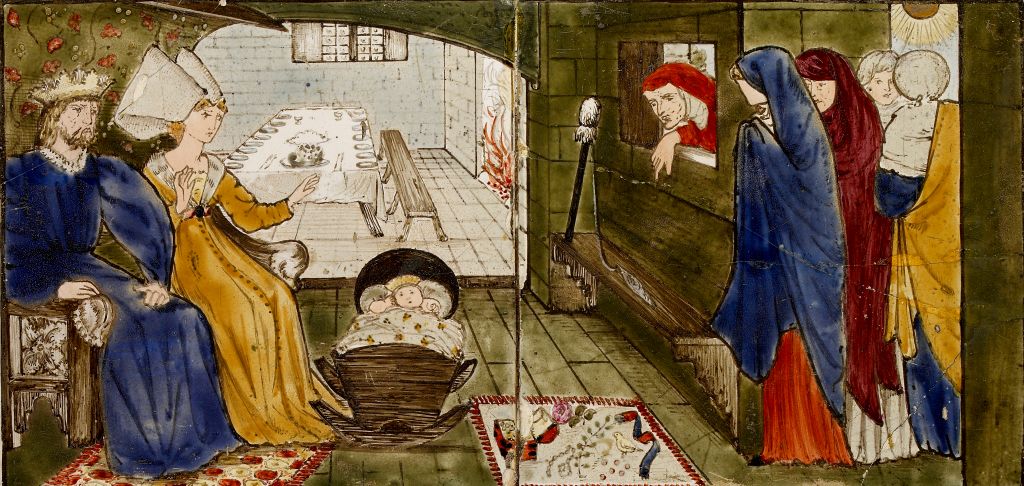In the heart of Shoreditch, a handful of arts students have strayed from their typical east London mould. Those who study at the Prince’s Foundation School of Traditional Arts are taught, through research and the practice of traditional arts and crafts, to ‘experience the beauty of the order of nature – a spiritual, sacred beauty, connecting the whole of creation.’
The School’s ethos is centred around the philosophical vision of its president, the King. Charles is known to have some woolly ideas about aesthetics and spirituality and alternative medicine, articulated in his 2010 book Harmony: A New Way of Looking at Our World. He exalts sacred geometry – the spiritual associations of shapes and proportions – as the fruit of a classical tradition of wisdom which reflects the natural world and is therefore unchanging. Paraphrasing Plato, geometry ‘is true for all peoples at all times.’
The creator of traditional art derives inspiration from ‘the highest sources’ and creates artworks ‘which we can all recognise as part of our world heritage,’ the School claims in its ethos – in other words, all cultures share an inherent sense of capital-B Beauty. The skills taught by the School, ranging from Byzantine iconography to biomorphic arabesques, are rooted in principles which it describes as ‘common to all traditional cultures,’ the most important principle being geometry.
When art fails to move us, we risk losing a significant source of genuine cultural understanding
While I’m not entirely sold on the School’s claim that geometry is a discipline ‘that can lead to self-development,’ I do think there is value in appealing to the head, the hands and especially the heart when teaching art. Whether the student is the one holding the brush or merely an observer of someone else’s brushstrokes, presence with art is essential – particularly when it can give us a better understanding of cultures and religious practices separate from our own.
The School is a sort of soft extension of the legacy of William Morris, one of the leading figures of the arts and crafts movement in Britain who trained apprentices in Gothic methods. While he is mostly known for his chintzy wallpapers, he married his aesthetic vision – inspired as much by the symmetry of the natural world as by religious art, such as Islamic geometry and English medieval manuscripts and stained glass – with a political one which vocally criticised the carnage of capitalism and industrialisation.
A few weeks ago, I spent my Friday evening at the Tate Britain for an event called ‘Love and Heartbreak,’ where the museum stayed open late with a schedule of workshops, talks, performances and DJ sets. The event was loosely inspired by the newly opened exhibition on the Rossetti family and the Pre-Raphaelites. Counted among the Rossettis’ contemporaries was William Morris, whose wife Jane became the muse, and perhaps lover, of Dante Gabriel Rossetti – one of the many Pre-Raphaelites romances, real or painted, which inspired the night’s theme.
I took the elevator to the museum’s upper level where the event was taking place. The DJ’s bass was so loud that when the metal doors took a little too long to open, I was concerned the industrial vibrations were a sign to slam the emergency help button. Visitors congregated in the ‘Art for the Crowd’ room where a bar had been set up. Somewhat disoriented by the dim red lighting, pulsing music and swaying bodies, I couldn’t tell if the gallery smelled like stale beer or weed or a combination of both.
‘To grab the attention of these crowds, artists choose literary and modern-life subjects that reflect ideas dominating their time,’ the Tate writes of the artworks from the period 1815-1905 which are compiled in this room. ‘They often overlook, caricature or romanticise the experiences of many people.’ It was somewhat ironic that the museum, clearly unsatisfied with the artists who had overlooked their subjects, was willing to replicate that neglect by using these paintings as what was essentially a backdrop for Instagram posts and BeReals.
In his documentary Ways of Seeing, the art critic John Berger lamented the ‘false mystery and false religiosity’ that we endow valuable artworks with, which ‘is in fact a substitute for what paintings lost when the camera made them reproducible.’ Like Morris, he was critical of the way technology was degrading our relationship with the material. When a work of art can be replicated by the touch of a finger, we find ways to make the art valuable separately from its image, for example by verifying that it is a genuine, say, da Vinci or Rembrandt. Row upon row of people will stretch their arms to snap photos of the Mona Lisa or The Night Watch to say we have seen them – this becomes more important than the art itself. In a world where photographs of copies of art are more familiar to us than their originals, where AI blurs the line between man-made and machine-made, where the explosion of the art market has shifted value from the art itself to its provenance and monetary value, genuine mystery becomes elusive.
Not every graduate of the Prince’s Foundation School will leave convinced of some objective or divinely-decreed notion of Beauty, but the purpose of encouraging a spiritual connection with art is not to extend an ideology. It is meant to enrich students – many of whom make their way to the cutting edge of contemporary art – with the fullest possible sense of art’s mystery.
When art fails to move us, we risk losing a significant source of genuine cultural understanding. We risk overlooking and caricaturising the crowd, or being cut off from the past. We can’t all submerge ourselves in the discipline of sacred geometry on our quest for self-betterment, but the practice can still teach us something about how to be present – mind, body and soul – with art.






Comments